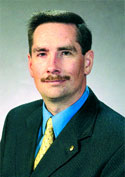
Features
Codes and standards
Hot topics
NFPA Impact: SCBA and PASS changes protect hazmat responders
The National Fire Protection Association has released its second edition of "A Needs Assessment of the U.S. Fire Service". It is unfortunate but we have no equivalent study on Canadian fire service needs. I believe, however, that culturally there is little difference in the operations of fire services across the border. It is therefore not a big leap in logic to assume that the same deficiencies found in the U.S. fire service might be found in Canada.
December 6, 2007
By Sean Tracey
 The
The
National Fire Protection Association has released its second edition of
"A Needs Assessment of the U.S. Fire Service". It is unfortunate but we
have no equivalent study on Canadian fire service needs. I believe,
however, that culturally there is little difference in the operations
of fire services across the border. It is therefore not a big leap in
logic to assume that the same deficiencies found in the U.S. fire
service might be found in Canada. Of interest is the change in the
number of departments equipped with self-contained breathing apparatus
and personal alert safety system devices. The NFPA study reports that
the percentage of departments without enough SCBA to equip a shift
declined by eight percentage points to 28 per cent from 36 per cent in
the four years between the two studies. The percentage without enough
PASS devices to equip a shift declined by 13 percentage points to 29
per cent from 42 per cent.
Both of these devices are
considered essential life-saving components. It is encouraging to see
the increase in numbers but there is still a way to go to meet the 100
per cent mark. Standards for both of these pieces of equipment have
gone through significant changes with the release of the 2007 editions.
In the case of SCBA, the changes represent a legal requirement to meet
U.S. federal workplace safety requirements. In the case of the PASS
devices, the changes are driven by the noted failure of the devices
under extreme conditions.
NFPA 1982, the standard for PASS
devices, was last issued in 1998. In a number of recent instances of
firefighter fatalities, the National Institute for Occupational Safety
and Health in the U.S. reported that PASS alarm signals were not heard
or were barely audible. These were devices that had been certified to
the standard. In 2005, NFPA issued an alert notice on this and a number
of changes were initiated to the standard. New, more stringent,
performance requirements were developed for these devices. If you
missed the information releases on PASS device failures you can see it
at www.nfpa.org.
What
does this mean for existing PASS device users? In spite of these
observed problems, the PASS device remains an essential piece of the
firefighter's kit.
PASS devices should continue to be used but
personnel need to be aware that under extreme conditions the
performance of the PASS device may be adversely affected. Personnel
should be aware that proper incident-command practices should be
followed on scene.
The major change to SCBA is that all
emergency services SCBA must now also be certified as chemical,
biological, radiological and nuclear (CBRN) in accordance with the
NIOSH statement of standard for CBRN SCBA testing. The NIOSH standards
were essential for U.S. acceptance of the SCBA as it is required that
any first responders performing any level of CBRN tasks must be
properly equipped for these tasks. The upside is that this also means
higher standards for protection of first responders in industrial
chemical incidents. In addition to the new CBRN requirement,
significant new requirements were added to increase the safety to the
users of emergency services SCBA and to better assure the proper
functioning of the SCBA. These include improvements in voice
communication performance, a new pressure gauge independent of the
heads-up display, water immersion tests for electronic devices that are
part of the SCBA (similar to the expectations of the PASS device
performance) and new, low-power capacity requirements for electronic
devices to ensure that such devices will continue to function properly
for at least two hours following activation of the low-power signal.
As
a final note, there is currently a joint Canadian Standards
Association/Canadian General Standards Board project to review Canadian
standards for CBRN protective clothing. This is an initiative being
funded by the Canadian Department of National Defence's CBRN Research
and Technology Initiative. Concerns have been raised by the fire
service on the intent of this project and these concerns have been
responded to by the CSA, which is encouraging the fire service to
participate through the Canadian Association of Fire Chiefs (which is a
member). The CSA's Ron Meyers says the intent of the project team is
"to provide guidance on the selection, use and care of PPE for use in
CBRN events.
"Guidance on the selection of appropriate PPE
will be based on realistic scenarios and the roles that responders
would play in a CBRN event."
Furthermore, he states, "A key
objective is also to provide information on the limitations and
capabilities of equipment as this will help responders in making
informed decisions when responding to a CBRN event."
Sean Tracey, P.Eng., is the Canadian regional manager of NFPA
International and formerly the Canadian Armed Forces Fire Marshal. He
may be reached at 613-830-9102, e-mail stracey@nfpa.org .
Print this page